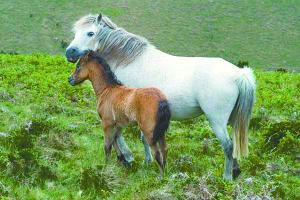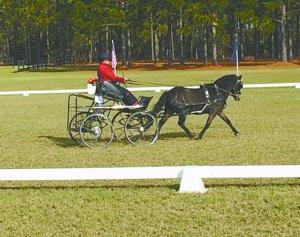U.S. Breeder Promotes Rare Dartmoor Ponies
Jack DeVroomen is one of the largest breeders of Dartmoor ponies in the U.S. and says anyone looking for calm, easy-to-work horses should take a look at the breed. Dartmoors are on the rare breed list with only about 150 to 200 registered animals in the U.S. and about 2,000 worldwide.
Dartmoor is moderator of Dartmoor Pony World, a Facebook page with about 2,000 followers, and he’s also head of the Dartmoor Pony Society of America, Inc.
Says DeVroomen, “I’m from Holland and my sisters learned to ride on Dartmoors. We went to England to buy ponies in the late 1960’s. Later in the U.S. I bought 3 mares and a stallion and have about 15 of them now. I name all of my new foals after tulips and use a system when I start with a new letter every year as we used to do in my native Holland.
Dartmoor ponies have lived in southwestern England for centuries, documented by historic bones found dating back to 3,500 B.C. In the 19th century they were known for carrying heavy loads of tin from the mines in the United Kingdom. Over the years Dartmoors gained acceptance as a hardy breed with excellent stamina and as a gentle breed friendly to children. The first attempt to define and register the breed occurred in 1898 when ponies were entered into a studbook started by the Polo Pony Society. In 1924 the official breed society was founded and continues today in England. The U.S. society is an official daughter society of the Dartmoor Pony Society in the UK.
Dartmoor horses are distinguished by a small head with large, wide-set eyes and alert ears. Their body is strong with a broad and deep rib cage. The mane and tail are full and flowing and their movement is free and smooth. They stand between 11 and 12.2 hands and can have bay, brown, black, grey, chestnut or roan coloring. Mature horses weigh about 550 to 625 lbs.
DeVroomen says two kinds of people typically buy a Dartmoor. Parents with young children who want a very docile and easy-to-handle pony are really impressed by these horses. Another group interested are people who drive carts for pleasure and competition. Older ladies like them because they’re a smaller animal and easier to handle.
Though he has 15 Dartmoors now and all have names and a special place in his family, DeVroomen says any one of them is for sale to the right buyer. “I’ve sold them all across the U.S. The price is typically about $2,000 for a grown animal, and I’m not making any money at that rate. It costs a lot to breed, feed and house them.”
DeVroomen enthusiastically tells the story of a Dartmoor colt born at his Carolina farm in 2008. “When Esperanto was weaned, I gave him to my grandaughter and she just loved him. He was calm, friendly and like a member of the family. Eventually she grew up and was large enough that she couldn’t ride him anymore. She trained him for a buggy, and I told her I’d sell him and put the money in her college fund. The buyer was a lady from the Carolina Carriage Club, and to this day Esperanto is still winning carriage races. And yes, my grandaughter got the money for her college fund!”
Contact: FARM SHOW Followup, Jack DeVroomen, Ware Shoals, S. Carolina (ph 864 980-7871; www.tulipking.wordpress.com; www.dartmoorpony.org; www.facebook.com/jack.devroomen).

Click here to download page story appeared in.
Click here to read entire issue
U S Breeder Promotes Rare Dartmoor Ponies LIVESTOCK Horses/Mules Jack DeVroomen is one of the largest breeders of Dartmoor ponies in the U S and says anyone looking for calm easy-to-work horses should take a look at the breed Dartmoors are on the rare breed list with only about 150 to 200 registered animals in the U S and about 2 000 worldwide
Dartmoor is moderator of Dartmoor Pony World a Facebook page with about 2 000 followers and he’s also head of the Dartmoor Pony Society of America Inc
Says DeVroomen “I’m from Holland and my sisters learned to ride on Dartmoors We went to England to buy ponies in the late 1960’s Later in the U S I bought 3 mares and a stallion and have about 15 of them now I name all of my new foals after tulips and use a system when I start with a new letter every year as we used to do in my native Holland
Dartmoor ponies have lived in southwestern England for centuries documented by historic bones found dating back to 3 500 B C In the 19th century they were known for carrying heavy loads of tin from the mines in the United Kingdom Over the years Dartmoors gained acceptance as a hardy breed with excellent stamina and as a gentle breed friendly to children The first attempt to define and register the breed occurred in 1898 when ponies were entered into a studbook started by the Polo Pony Society In 1924 the official breed society was founded and continues today in England The U S society is an official daughter society of the Dartmoor Pony Society in the UK
Dartmoor horses are distinguished by a small head with large wide-set eyes and alert ears Their body is strong with a broad and deep rib cage The mane and tail are full and flowing and their movement is free and smooth They stand between 11 and 12 2 hands and can have bay brown black grey chestnut or roan coloring Mature horses weigh about 550 to 625 lbs
DeVroomen says two kinds of people typically buy a Dartmoor Parents with young children who want a very docile and easy-to-handle pony are really impressed by these horses Another group interested are people who drive carts for pleasure and competition Older ladies like them because they’re a smaller animal and easier to handle
Though he has 15 Dartmoors now and all have names and a special place in his family DeVroomen says any one of them is for sale to the right buyer “I’ve sold them all across the U S The price is typically about $2 000 for a grown animal and I’m not making any money at that rate It costs a lot to breed feed and house them ”
DeVroomen enthusiastically tells the story of a Dartmoor colt born at his Carolina farm in 2008 “When Esperanto was weaned I gave him to my grandaughter and she just loved him He was calm friendly and like a member of the family Eventually she grew up and was large enough that she couldn’t ride him anymore She trained him for a buggy and I told her I’d sell him and put the money in her college fund The buyer was a lady from the Carolina Carriage Club and to this day Esperanto is still winning carriage races And yes my grandaughter got the money for her college fund!”
Contact: FARM SHOW Followup Jack DeVroomen Ware Shoals S Carolina ph 864 980-7871; www tulipking wordpress com; www dartmoorpony org; www facebook com/jack devroomen
To read the rest of this story, download this issue below or click
here to register with your account number.








